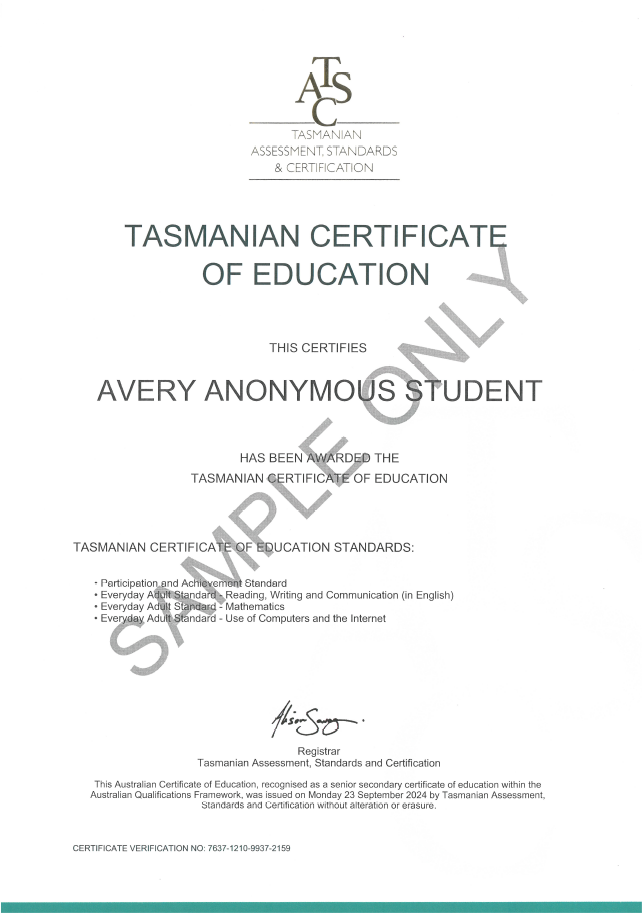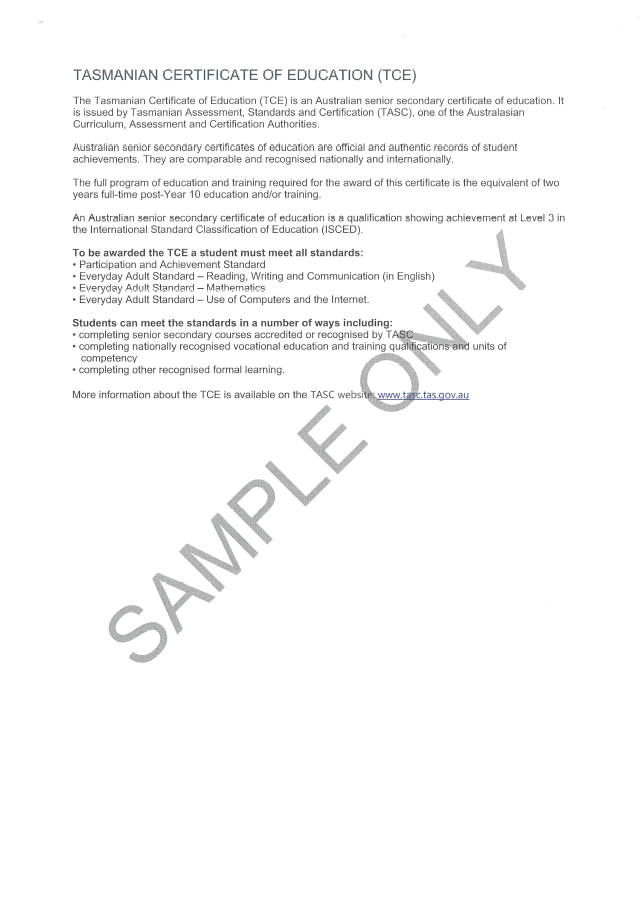Issued to learners who meet the Participation and Achievement Standard and the Everyday Adult Standards
The Tasmanian Certificate of Education (TCE) is the Tasmanian senior secondary certificate requiring the highest level of educational achievement.
The TCE recognises skills and capabilities at a senior secondary level and can be attained though at least two years of study in VET, TASC-accredited Year 11 and 12 courses and recognised formal learning. (Attainment of the TCE and successful completion of at least four Level 3 and 4 TASC-accredited courses is required to be eligible for an ATAR for university entrance.)
The TCE certifies that you have:
- completed a minimum of two years of further education and training after Year 10
- met the Participation and Achievement Standard by completing a combination of study options to attain sufficient TCE credit points
- demonstrated the three Everyday Adult Standards.
The TCE is awarded to all Tasmanians who reach the prescribed TCE standards detailed below.
You can achieve the TCE when you complete your senior secondary years of education and training. Or you can achieve the TCE any time throughout your life by completing further education and training and/or sitting the Everyday Adult Standards safety net tests.
Watch the video What is the TCE?
TCE standards
To achieve the TCE, you need to meet all of the TCE standards:
- Participation and Achievement Standard: 120 credit points (with at least 80 credit points in studies at Level 2 or higher).
- Everyday Adult Standards:
- Reading, Writing and Communication (in English)
- Mathematics
- Use of Computers and the Internet.
CHECK you are on track to achieve the TCE using our TCE Achievement Checklist and TCE Course Planner.
Your school can help you plan a program of study for you to achieve the TCE. The TCE requirements can be met in different ways and in different settings.
Meeting the Participation and Achievement Standard
There are a wide range of courses that provide credit points towards the Participation and Achievement Standard. You can choose:
- TASC accredited courses
- vocational education and training (VET) courses
- nationally or interstate assessed languages (by application)
- recognised formal learning
- the University of Tasmania’s University Connections Program and the High Achiever Program (for eligible students)
- or a combination of these to make up your program of study.
The TCE Course Planner or Courses page will show you how many TCE credit points you can receive for each course. To receive the credit points for a TASC accredited course, you need to complete the course with an award of Preliminary Achievement (or higher) – see Your results.
Meeting the Everyday Adult Standards
The Everyday Adult Standards are core skills, knowledge and capabilities that are needed in everyday adult life and work.
You must meet all the Everyday Adult Standards to achieve the TCE. You can show that you meet the standards by:
- successfully completing a course that includes that standard
- sitting and passing an Everyday Adult Standard safety net test
- NB: until further notice, the Everyday Adult Standard: Use of Computers and the Internet Standard will be given automatically as recognition of use of computers and the internet if a student has achieved all the other TCE standards [the Participation and Achievement Standard, Everyday Adult Standard: Reading, Writing and Communication (in English) and Everyday Adult Standard: Mathematics], with final verification made via the Principal Declaration.
The TCE Course Planner or Courses page will show you if a course includes an Everyday Adult Standard. To demonstrate you meet the Standard embedded in a course, you need to successfully complete the course with an award of Satisfactory Achievement (or higher) – see Your results.
Example: TCE Certificate



